Wireless Power Transfer via Subterahertz-Wave
Abstract
1. Introduction
2. Wireless Power Beaming
3. Research Report on Millimeter-Wave High-Power Wireless Power Transmission
3.1. 28 GHz Rectenna
3.2. 94 GHz Rectenna
- (1)
- Aluminum is sputtered or vapor-deposited on the Si wafer (considering the skin depth).
- (2)
- Apply a photosensitive resist on it.
- (3)
- Draw the circuit pattern using the electron beam drawing apparatus.
- (4)
- Develop with TMAH (Tetramethylammonium hydroxide)
- (5)
- The resist is peeled off. The mixed acid aluminum etching solution etches the exposed Al.
- (6)
- Only the Al circuit pattern remains.
- (1)
- Aluminum is sputtered or vapor-deposited on the Si wafer (considering the skin depth).
- (2)
- Apply a photosensitive resist on it.
- (3)
- Draw the circuit pattern using the electron beam drawing apparatus.
- (4)
- Develop with TMAH.
- (5)
- The resist is peeled off. Then the mixed acid aluminum etching solution etches the exposed Al. Only the circuit pattern is exposed Si.
- (6)
- Silicon is etched by deep silicon device to complete silicon mask.
- (7)
- Cover the dielectric substrate with a silicon mask and Al sputtering or vapor-evaporation.
3.3. 303 GHz Rectenna
4. Conclusions
Author Contributions
Funding
Conflicts of Interest
References
- Shinohara, N. Recent Wireless Power Transfer Technologies via Radio Waves; River Publishers: Gistrup, Denmark, 2018. [Google Scholar]
- Ye, J.; Yang, C.; Zhang, Y. Design and experiment of a rectenna array base on GaAs transistor for microwave power transmission. In Proceedings of the 2016 IEEE International Conference on Microwave and Millimeter Wave Technology (ICMMT), Beijing, China, 5–8 June 2016. [Google Scholar]
- Suh, Y.H.; Chang, K. A high efficiency dual-frequency rectenna for 2.45- and 5.8-GHz wireless power transmission. IEEE Trans. Microw. Theory Tech. 2002, 50, 1784–1789. [Google Scholar] [CrossRef]
- Yoo, T.W.; Chang, K. Theoretical and Experimental Development of 10 and 35 GHz Rectennas. IEEE Trans. Microw. Theory Tech. 1992, 40, 1259–1266. [Google Scholar] [CrossRef]
- Nakamura, M.; Yamaguchi, Y.; Tsuru, M.; Aihara, Y.; Yamamoto, A.; Homma, Y.; Taniguchi, E. Prototype of 5.8 GHz-band high efficiency rectifier with a high breakdown voltage GaAs SBD. In Proceeding of the Institute of Electronics, Information and Communication engineers, Minato-ku, Tokyo, Japan, 16–17 April 2015; Volume 115, pp. 21–25. [Google Scholar]
- Yang, X.; Xu, J.; Xu, D.; Xu, C. X-band circularly polarized rectennas for microwave power transmission applications. J. Electron. (China) 2008, 25, 389. [Google Scholar] [CrossRef]
- Hatano, K.; Shinohara, N.; Seki, T.; Kawashima, M. Development of improved 24 GHz-band class-F load rectennas. In Proceedings of the 2012 IEEE MTT-S International Microwave Workshop Series on Innovative Wireless Power Transmission: Technologies, Systems, and Applications (IMWS), IMWS-IWPT 2012, Kyoto, Japan, 10–11 May 2012; pp. 163–166. [Google Scholar]
- Koert, P.; Cha, J.T. Millimeter wave technology for spacepower beaming. IEEE Trans. Microwave Theory Tech. 1992, 40, 1251–1258. [Google Scholar] [CrossRef]
- Mavaddat, A.; Armaki, S.H.M.; Erfanian, A.R. Millimeter-Wave Energy Harvesting Using Microstrip Patch Antenna Array. IEEE Antennas Wirel. Propag. Lett. 2015, 14, 515–518. [Google Scholar] [CrossRef]
- Nariman, M.; Shirinfar, F.; Pamarti, S.; Rofougaran, A.; De Flaviis, F. High efficiency Millimeter-Wave Energy-Harvesting Systems with Milliwatt-Level Output Power. IEEE Trans. Circuits Syst. Express Briefs 2017, 64, 605–609. [Google Scholar] [CrossRef]
- Kamalinejad, P.; Mahapatra, C.; Sheng, Z.; Mirabbasi, S.; Leung, V.C.; Guan, Y.L. Wireless energy harvesting for the Internet of Things. IEEE Commun. Mag. 2015, 53, 102–108. [Google Scholar] [CrossRef]
- Vamvakas, P.; Tsiropoulou, E.E.; Vomvas, M.; Papavassiliou, S. Adaptive power management in wireless powered communication networks: A user-centric approach. In Proceedings of the 2017 IEEE 38th Sarnoff Symposium, Newark, NJ, USA, 18–20 September 2017. [Google Scholar]
- Gao, H.; Matters-Kammerer, M.; Harpe, P.; Milosevic, D.; Johannsen, U.; Roermund, A.V.; Baltus, P. A 71GHz RF energy harvesting tag with 8% efficiency for wireless temperature sensors in 65 nm CMOS. In Proceedings of the 2013 IEEE Radio Frequency Integrated Circuits Symposium (RFIC), Seattle, WA, USA, 2–4 June 2013. [Google Scholar]
- Hemour, S.; Lorenz, C.H.P.; Wu, K. Small-footprint wideband 94 GHz rectifier for swarm micro-robotics. In Proceedings of the 2015 IEEE MTT-S International Microwave Symposium (IMS), Phoenix, AZ, USA, 17–22 May 2015; Volume I, pp. 5–8. [Google Scholar]
- Chiou, H.-K.; Chen, I.-S. High efficiency Dual-Band On-Chip Rectenna for 35- and 94-GHz Wireless Power Transmission in 0.13-μm CMOS Technology. IEEE Trans. Microw. Theory Tech 2010, 58, 3598–3606. [Google Scholar]
- Weissman, N.; Jameson, S.; Socher, E. W-Band CMOS On-Chip Energy Harvester and Rectenna. In Proceedings of the 2014 IEEE MTT-S International Microwave Symposium (IMS2014), Tampa, FL, USA, 1–6 June 2014. [Google Scholar]
- Hatano, K.; Shinohara, N.; Mitani, T.; Seki, T.; Kawashima, M. Development of 24 GHz-Band MMIC Rectenna. In Proceedings of the 2013 IEEE Radio and Wireless Symposium (RWS 2013), Austin, TX, USA, 20–23 January 2013; Volume 50, pp. 199–201. [Google Scholar]
- Komurasaki, K.M.K.; Hatakeyama, W.; Okamoto, Y.; Minakawa, S.; Suzuki, M.; Shimamura, K.; Mizushima, A.; Fujiwara, K.; Yamaoka, H. Microstrip antenna and rectifier for wireless power transfer at 94 GHz. In Proceedings of the 2017 IEEE Wireless Power Transfer Conference (WPTC), Taipei, Taiwan, 10–12 May 2017; pp. 1–3. [Google Scholar]
- Trew, R.J. SiC and GaN Transistors—Is There One Winner for Microwave Power Applications? Proc. IEEE 2002, 90, 1032–1047. [Google Scholar] [CrossRef]
- Dickinson, R.M. Power in the sky: Requirements for microwave wireless power beamers for powering high-altitude platforms. IEEE Microwave Mag. 2013, 14, 36–47. [Google Scholar] [CrossRef]
- Thumm, M. State-of-the-Art of High Power Gyro-Device and Free Electron Masers; KIT Scientific Reports 7735; KIT Scientific Publishing: Karlsruhe, Germany, 2017; p. 7735. [Google Scholar]
- Etinger, A.; Pilossof, M.; Litvak, B.; Hardon, D.; Einat, M.; Kapilevich, B.; Pinhasi, Y. Characterization of a Schottky Diode Rectenna for Millimeter Wave Power Beaming Us-ing High Power Radiation Sources. Acta Phys. Pol. A 2017, 131, 1280–1284. [Google Scholar] [CrossRef]
- Suzuki, M.; Matsukura, M.; Mizojiri, S.; Shimamura, K.; Yokota, S.; Kariya, T.; Minami, R. Consideration of long distance WPT using 28 GHz gyrotron. Space Sol. Power Syst. 2018, 3, 45–48. (In Japanese) [Google Scholar]
- Mizojiri, S.; Shimamura, K.; Fukunari, M.; Minakawa, S.; Yokota, S.; Yamaguchi, Y.; Tatematsu, Y.; Saito, T. Subterahertz Wireless Power Transmission Using 303-GHz Rectenna and 300-kW-Class Gyrotron. IEEE Microw. Wirel. Components Lett. 2018, 28, 834–836. [Google Scholar] [CrossRef]
- Kariya, T.; Imai, T.; Minami, R. Development of High Power Gyrotron for Nuclear Fusion Reactor. J. Plasma Fusion Res. 2017, 93, 146–149. [Google Scholar]
- Fujiwara, K.; Kobayashi, T. Low-cost W-band frequency converter with broad-band waveguide-to-microstrip transducer. In Proceedings of the 2016 Global Symposium on Millimeter Waves (GSMM) & ESA Workshop on Millimetre Wave Technology and Applications, Espoo, Finland, 6–8 June 2016; pp. 1–4. [Google Scholar]
- Volakis, J.L. Antenna Engineering Handbook, 4th ed.; McGraw-Hill Education: New York, NY, USA, 2017. [Google Scholar]
- Yamaguchi, Y.; Kasa, J.; Saito, T.; Tatematsu, Y.; Kotera, M.; Kubo, S.; Shimozuma, T.; Tanaka, K.; Nishiura, M. High Power 303 GHz gyrotron for CTS in LHD. J. Instrum. 2015, 10, C10002. [Google Scholar] [CrossRef]
- Saito, T.; Yamaguchi, Y.; Tatematsu, Y.; Fukunari, M.; Hirobe, T.; Tanaka, S.; Shinbayashi, R.; Shimozuma, T.; Kubo, S.; Tanaka, K.; et al. Development of 300 GHz Band Gyrotron for Collective Thomson Scattering Diagnostics in the Large Helical Device. Plasma Fusion Res. 2017, 12, 126013. [Google Scholar] [CrossRef]
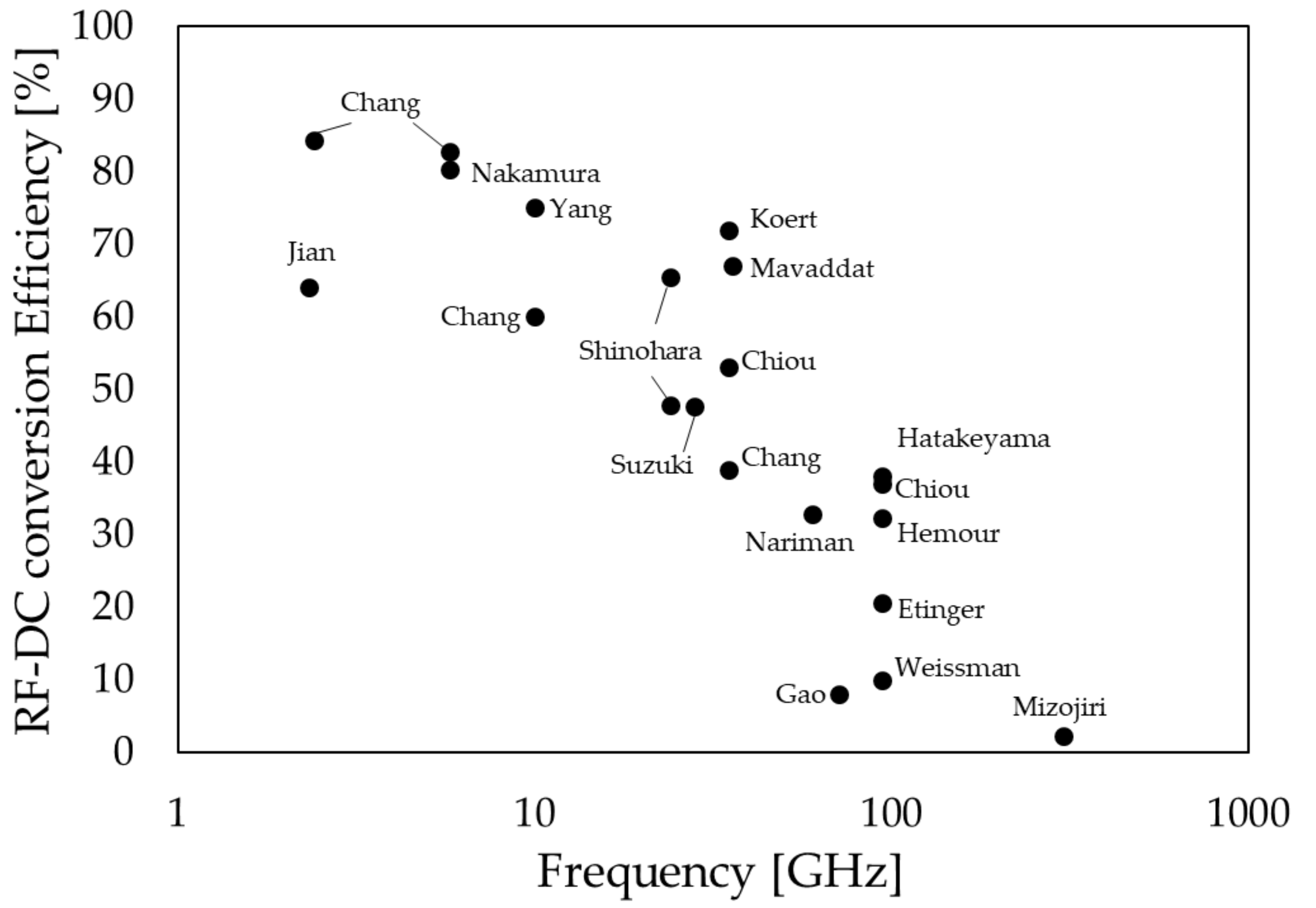

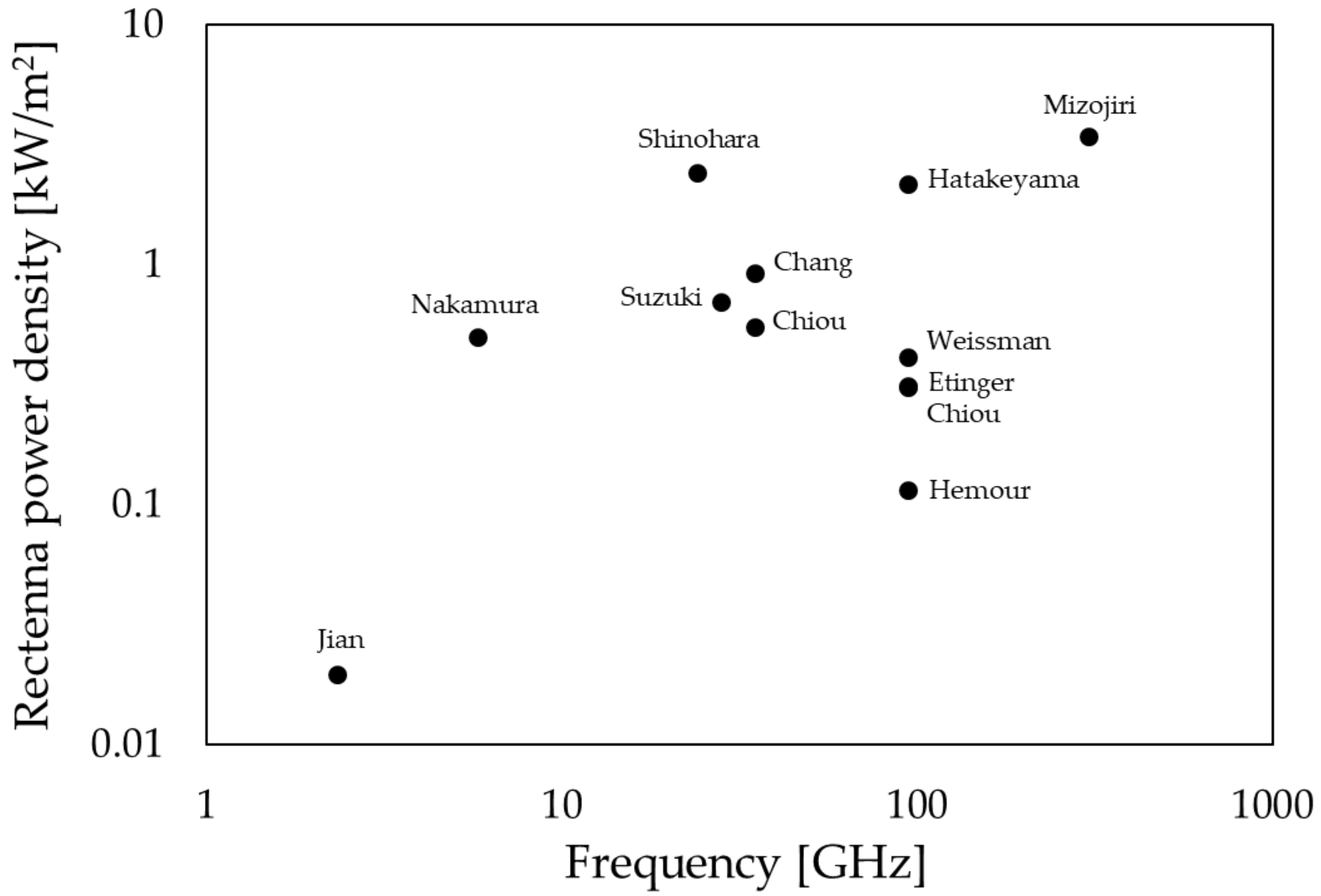
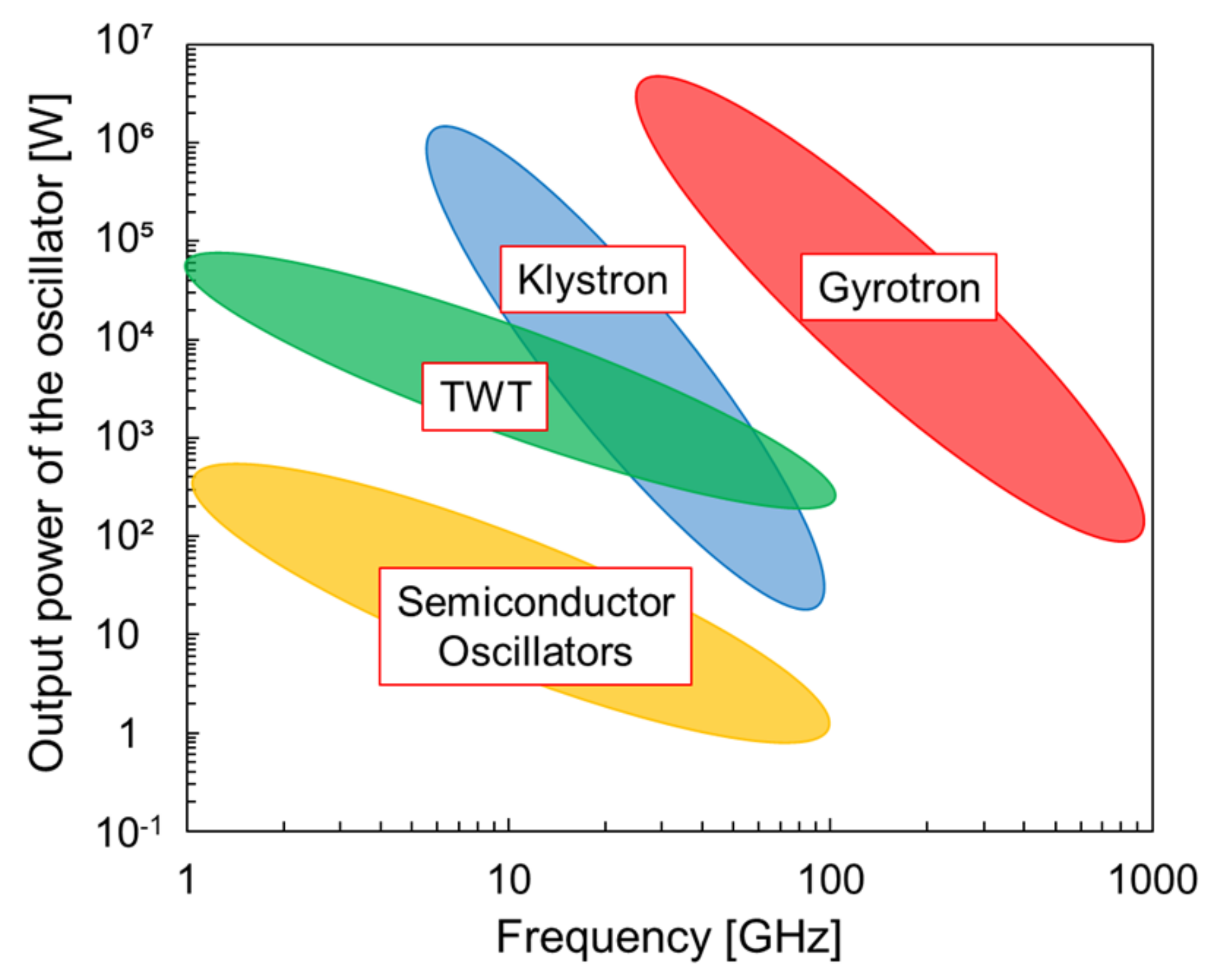
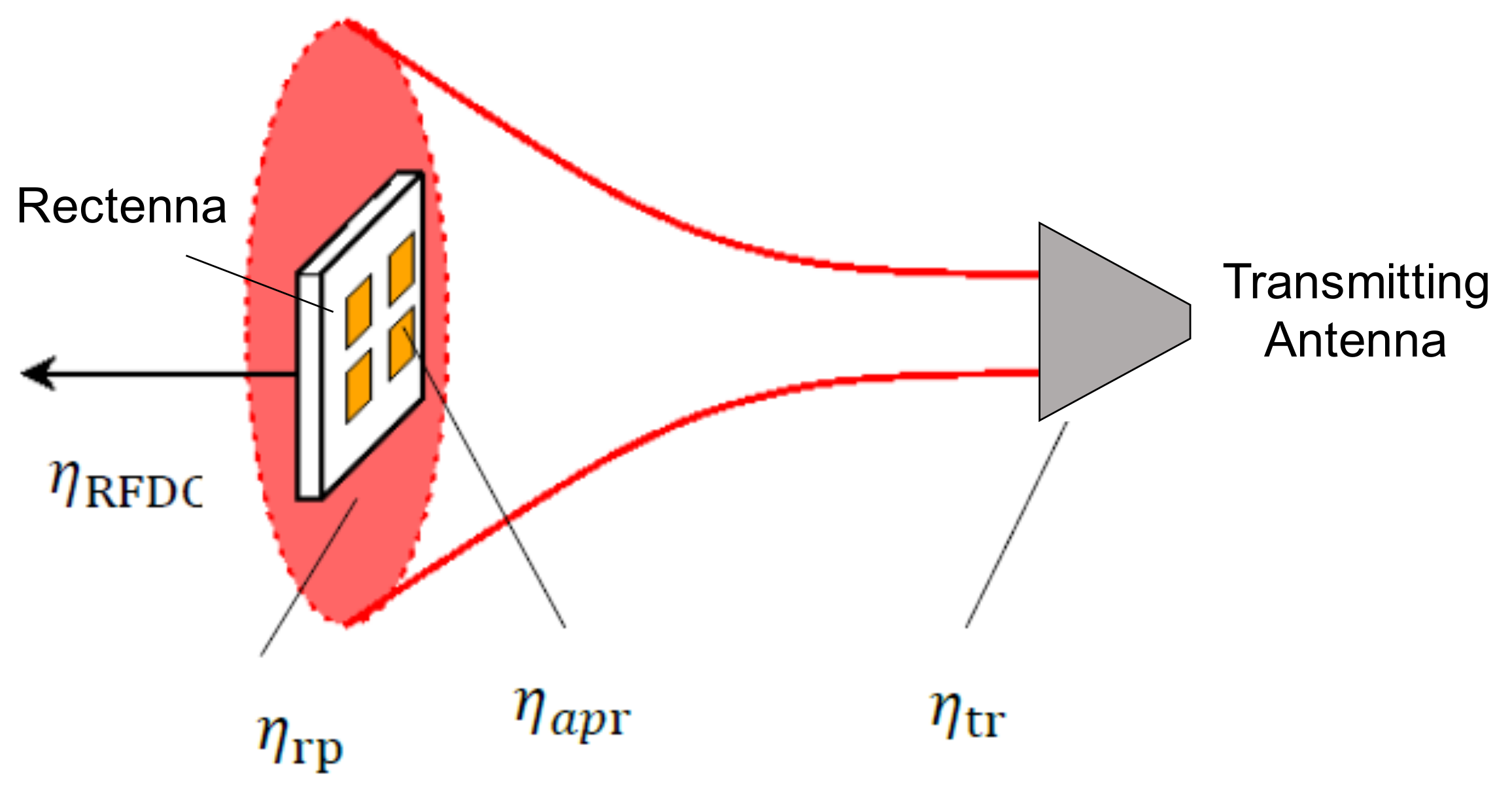

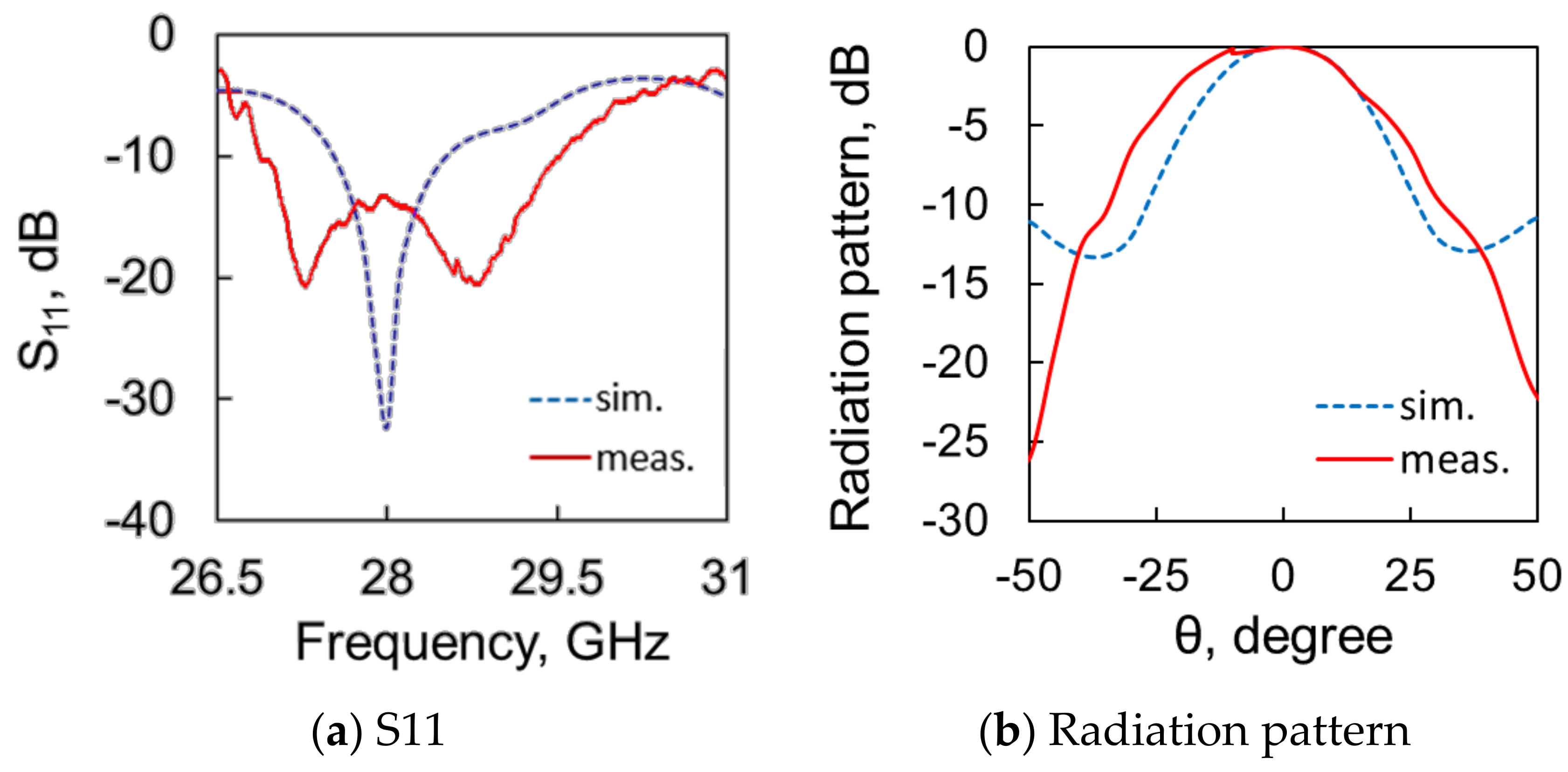
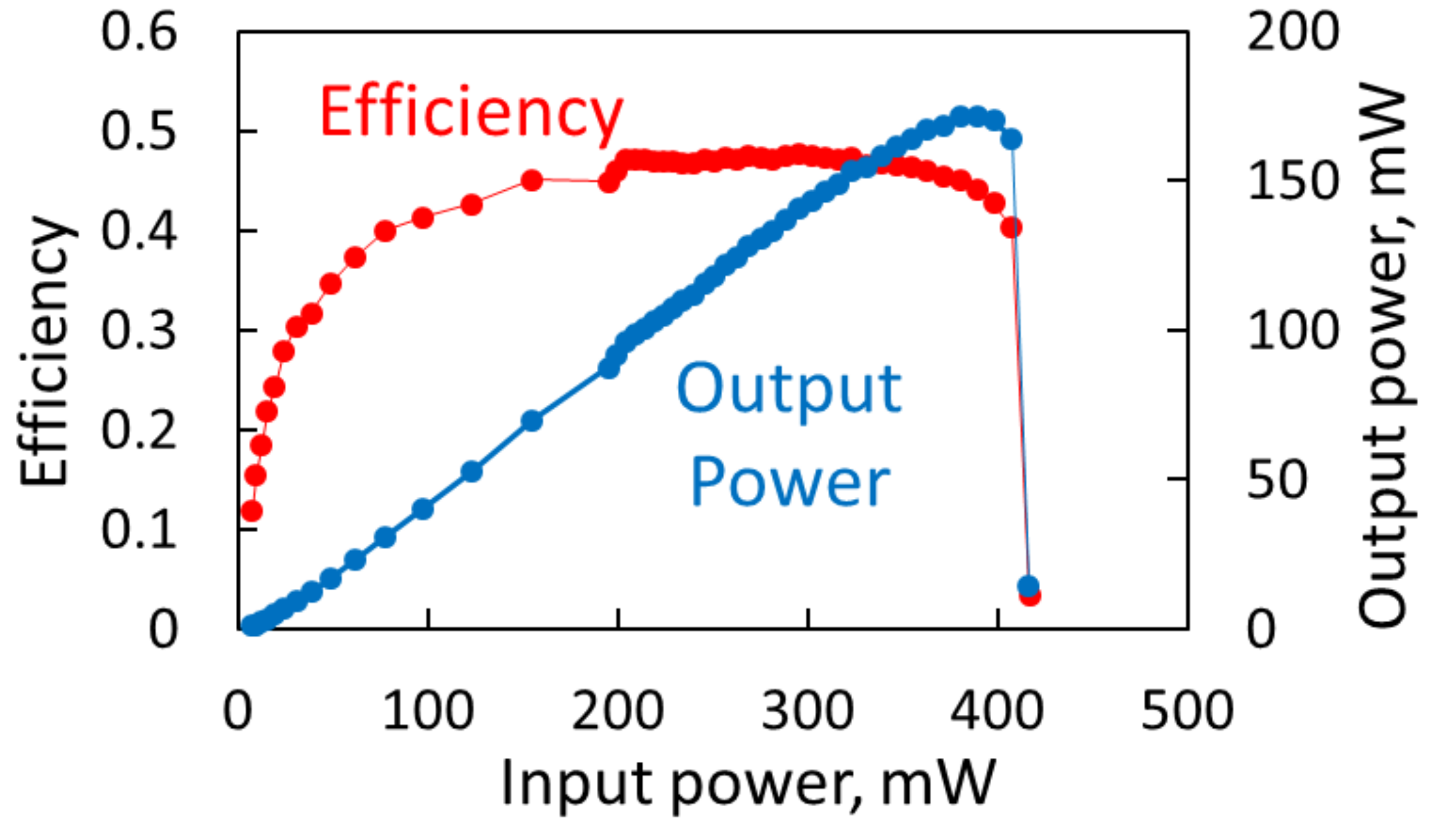
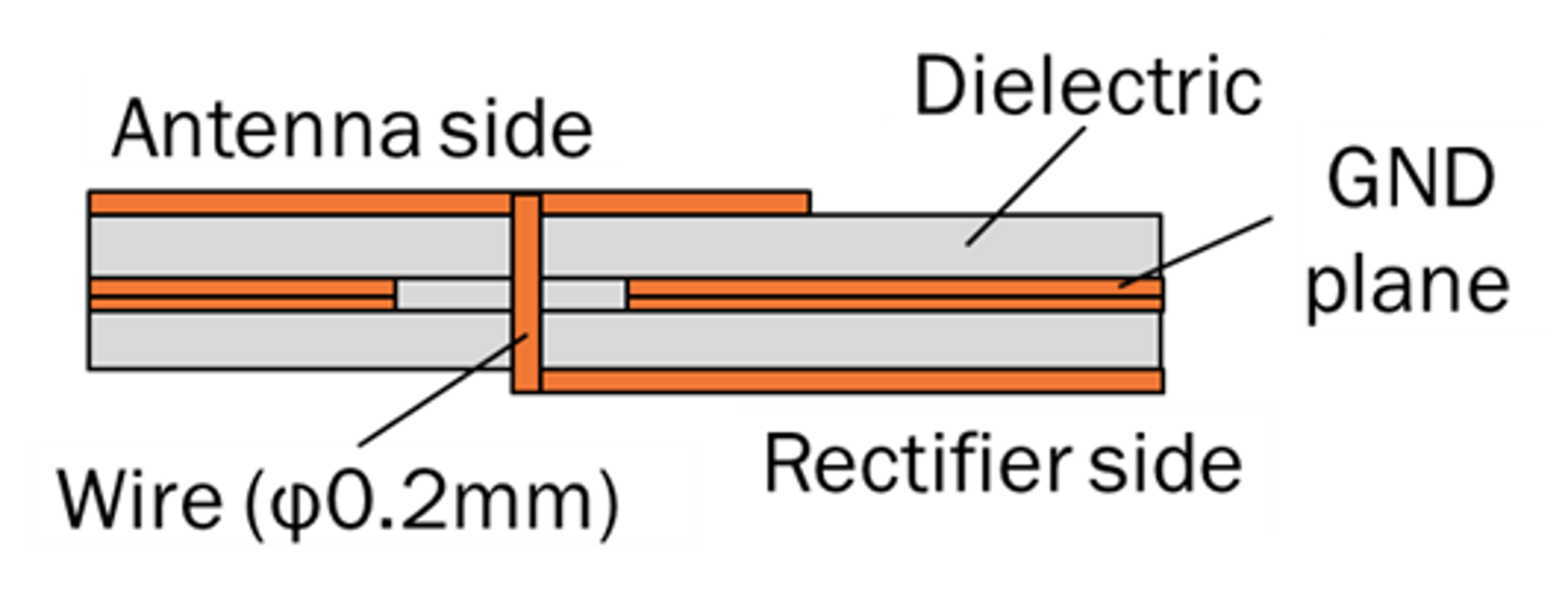
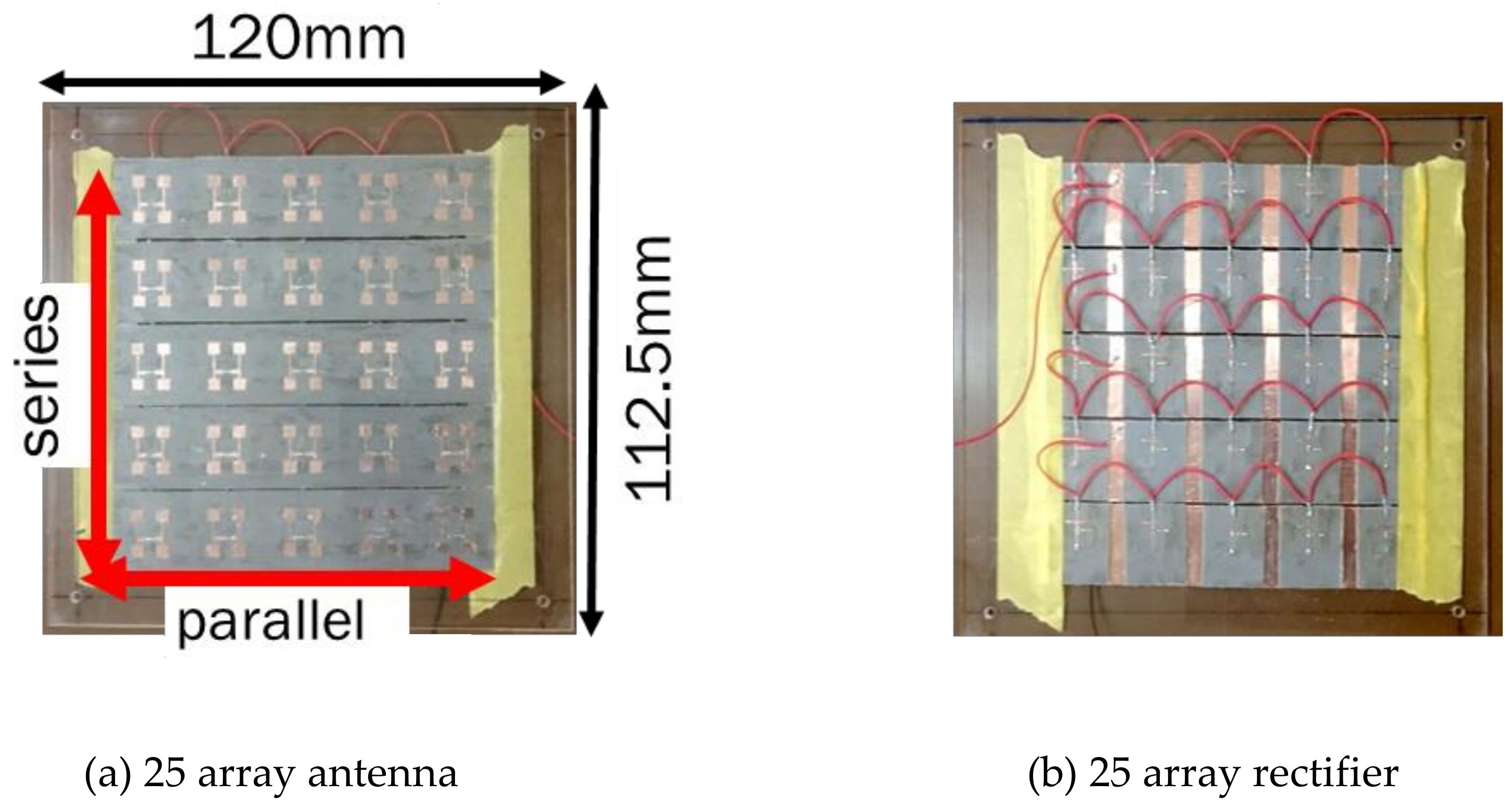
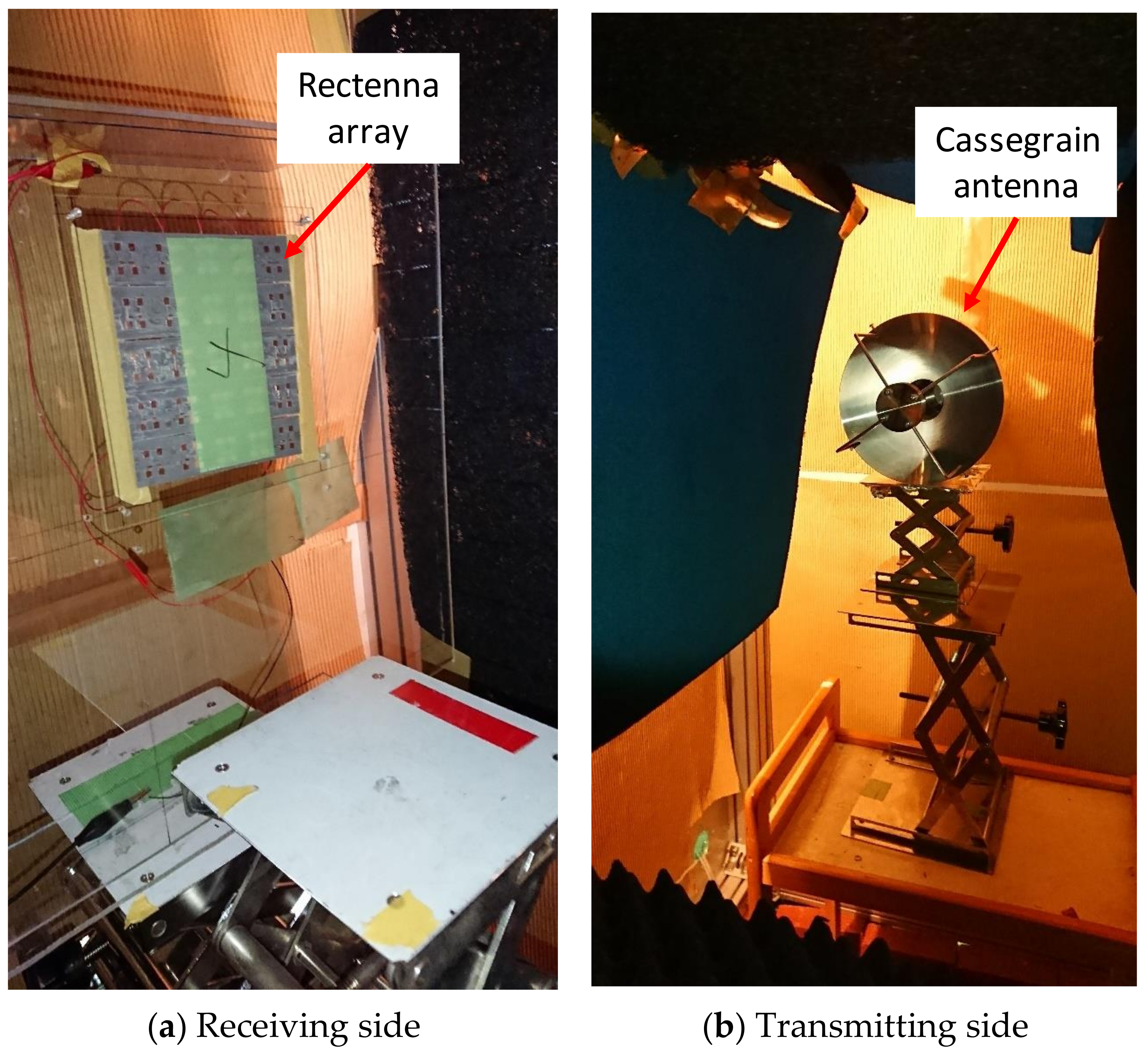
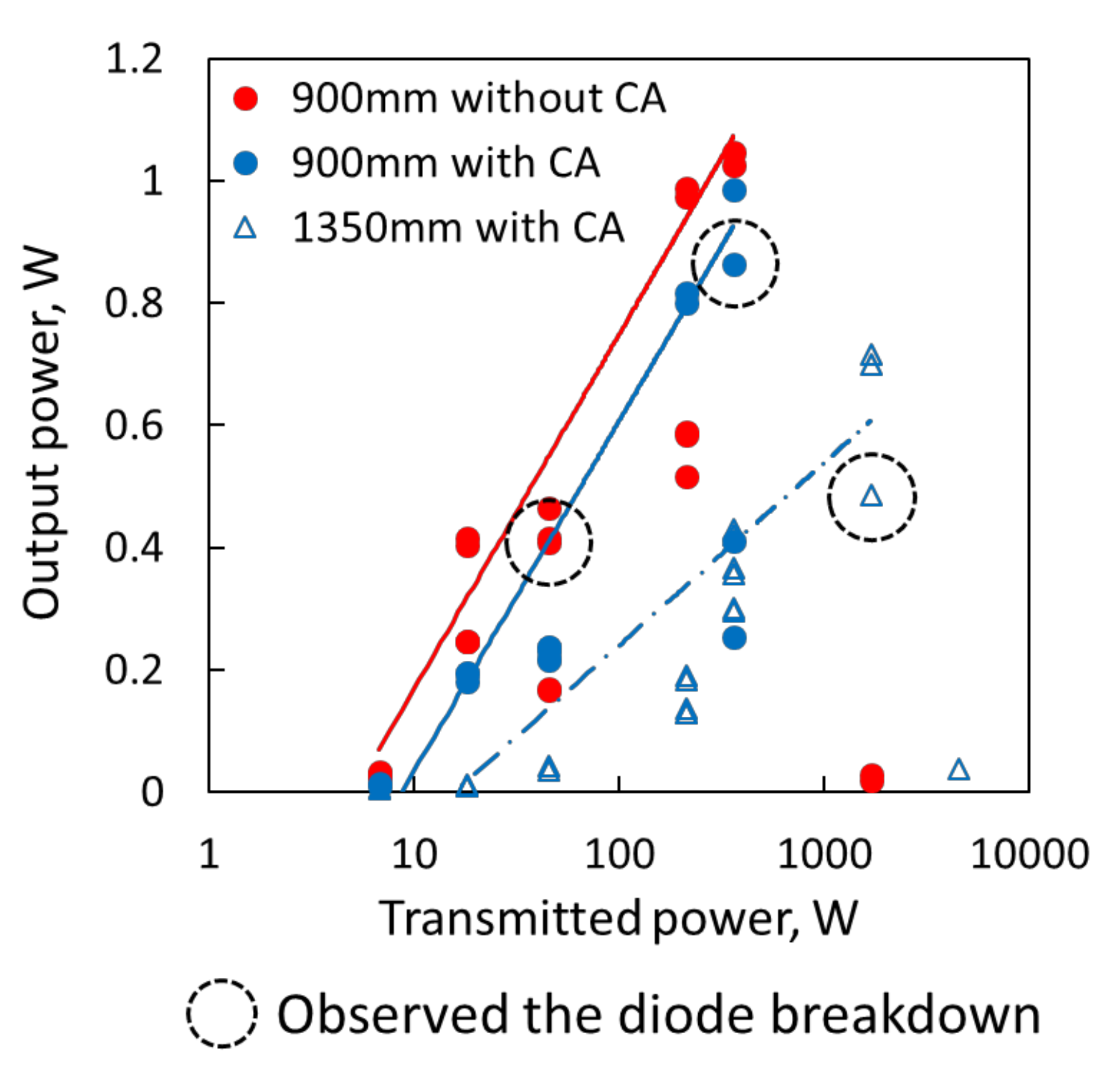
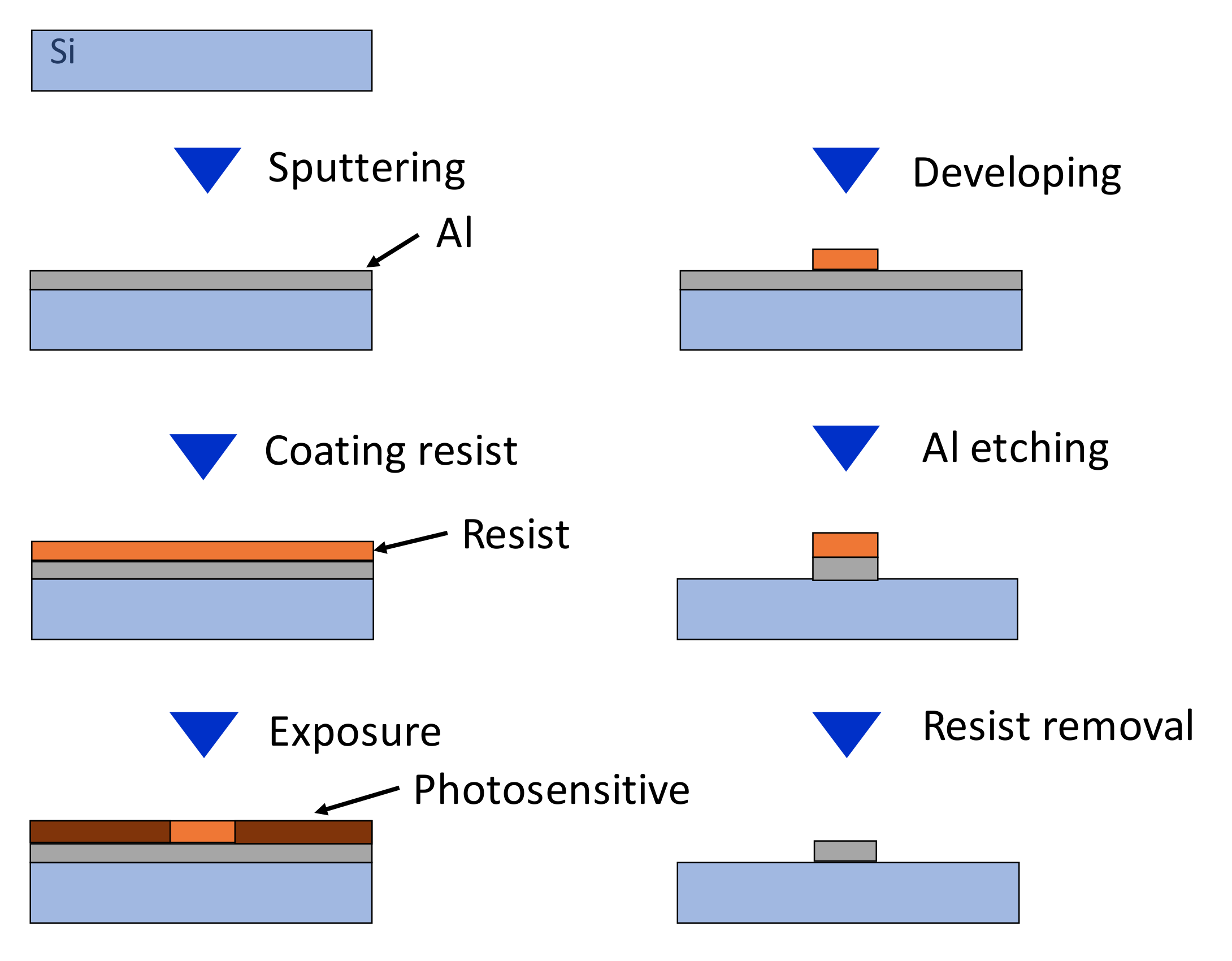
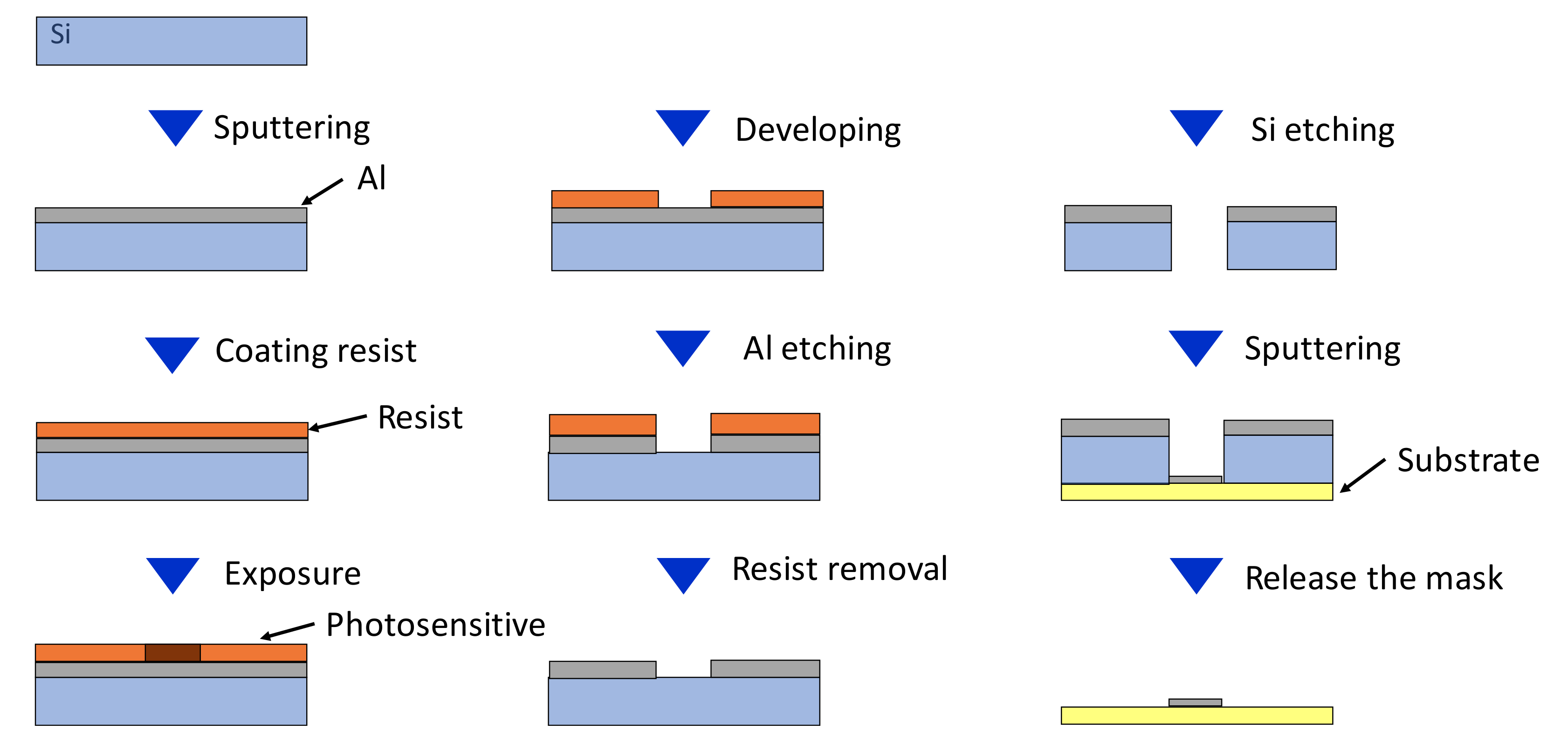

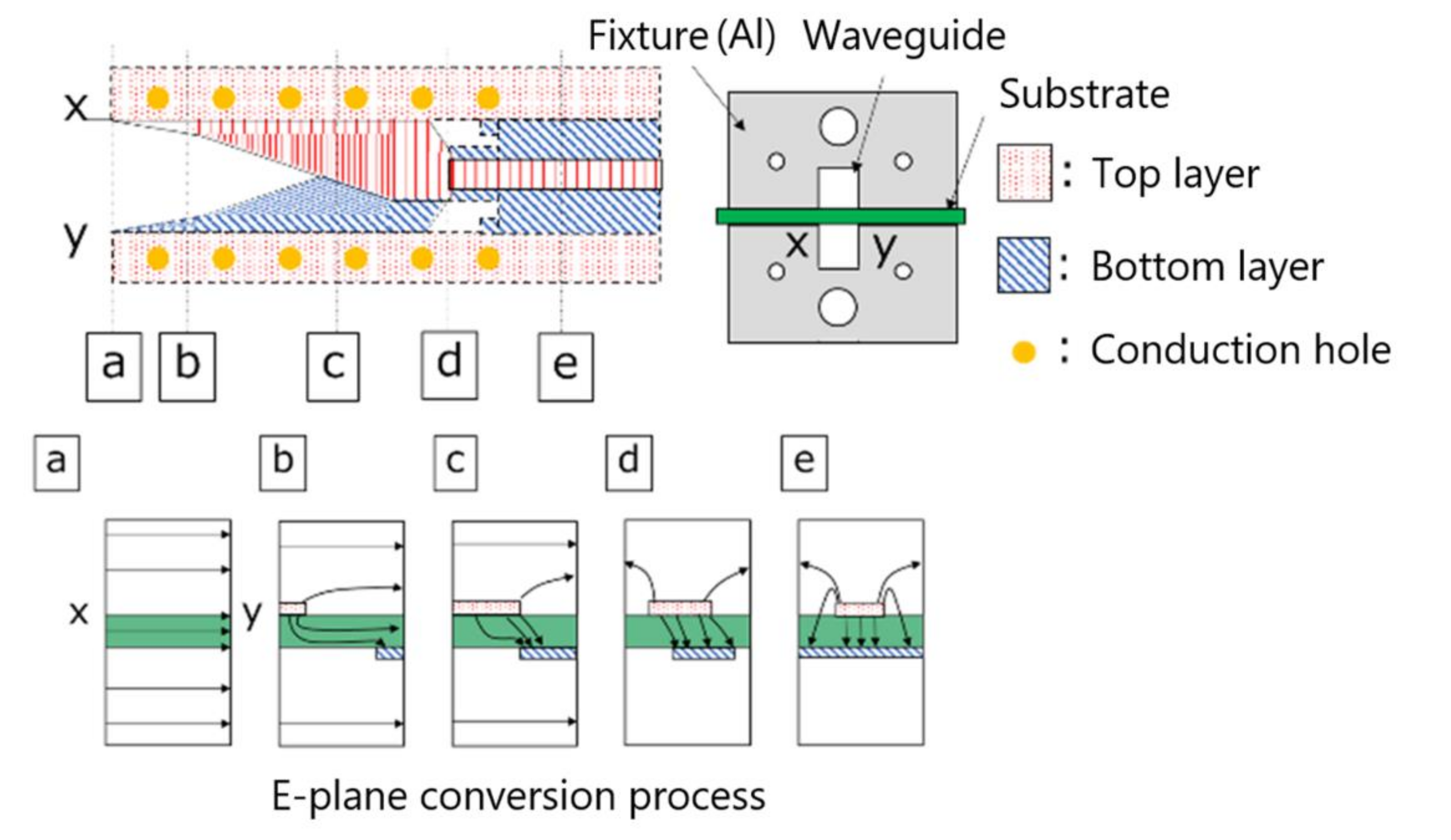
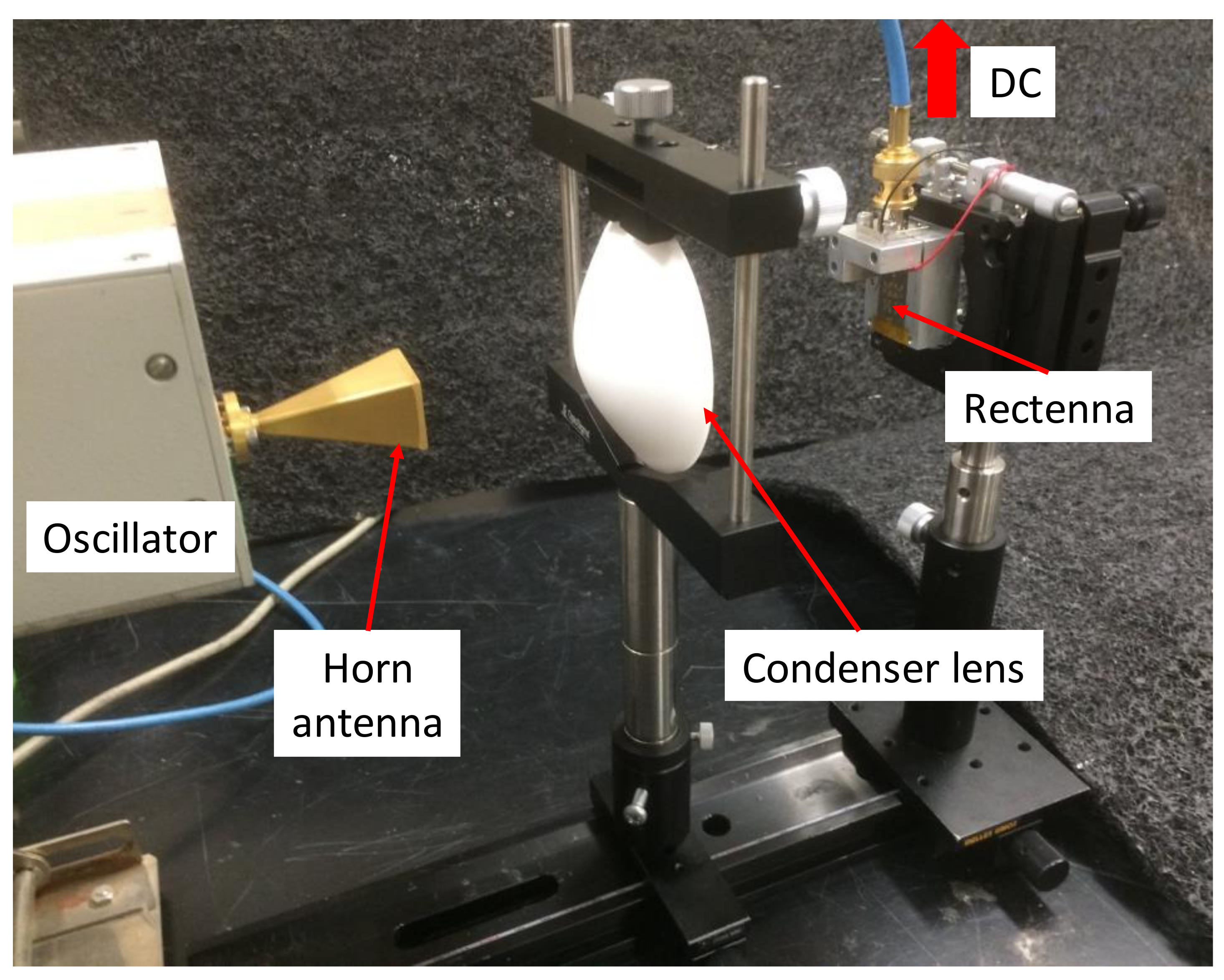
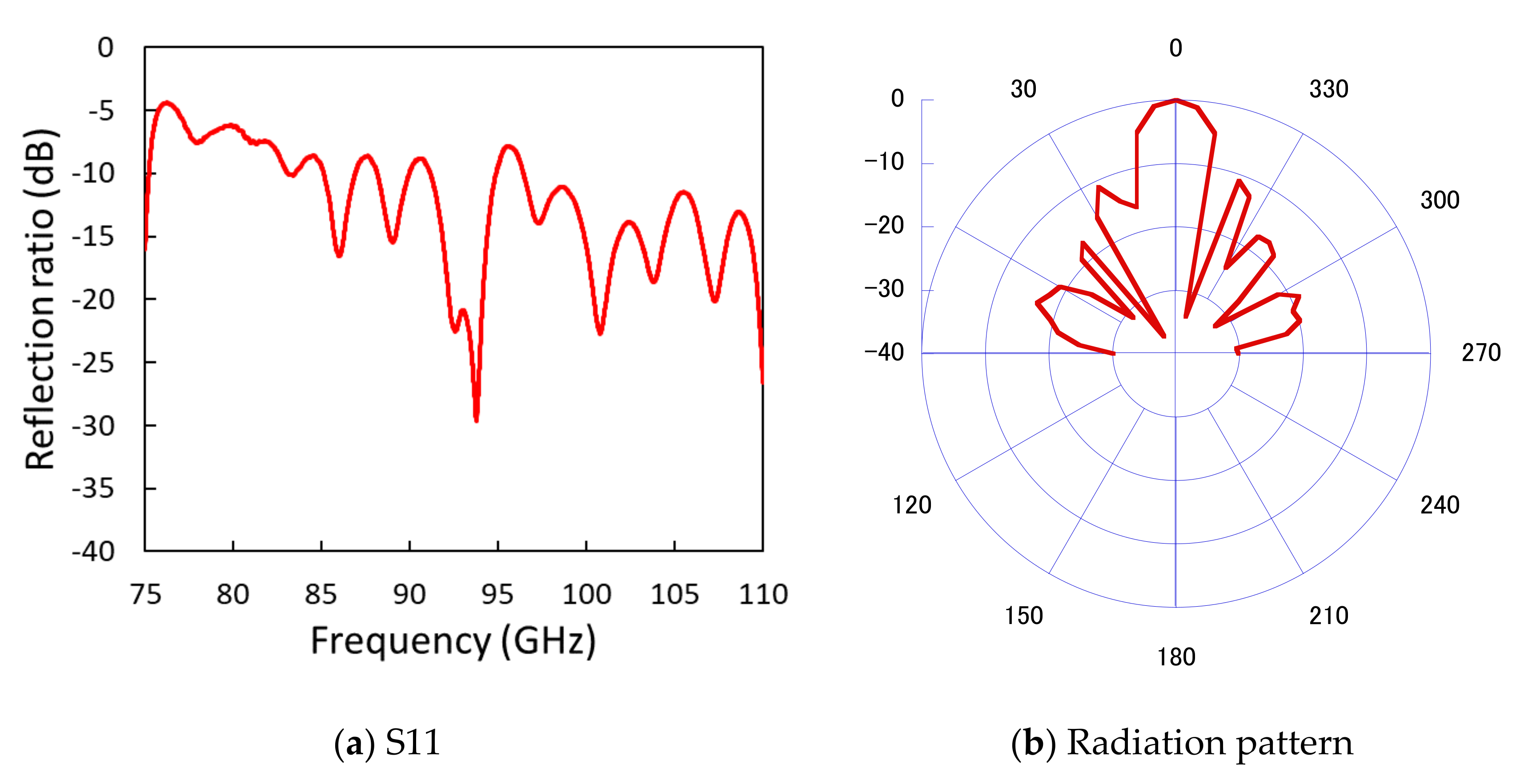
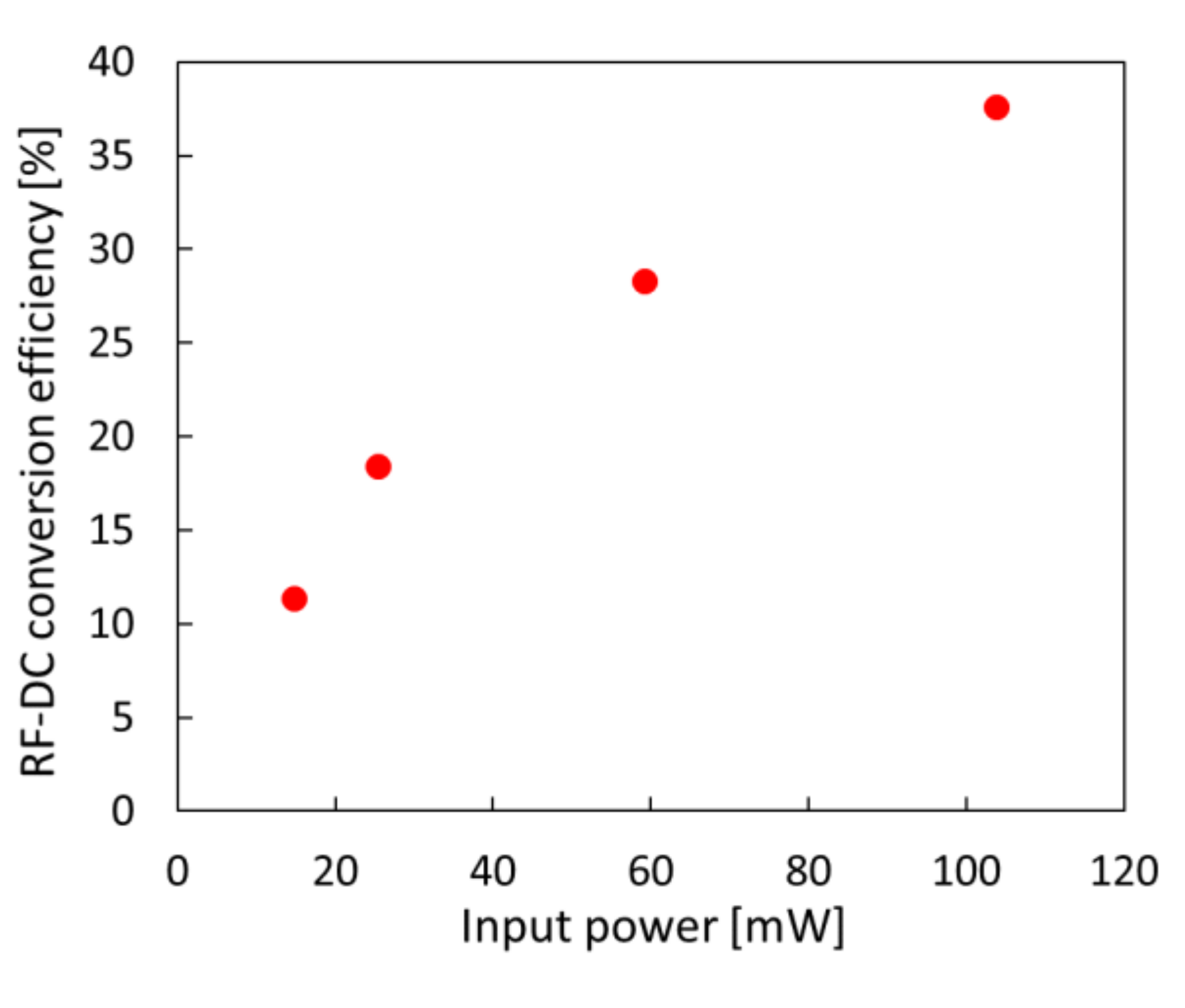
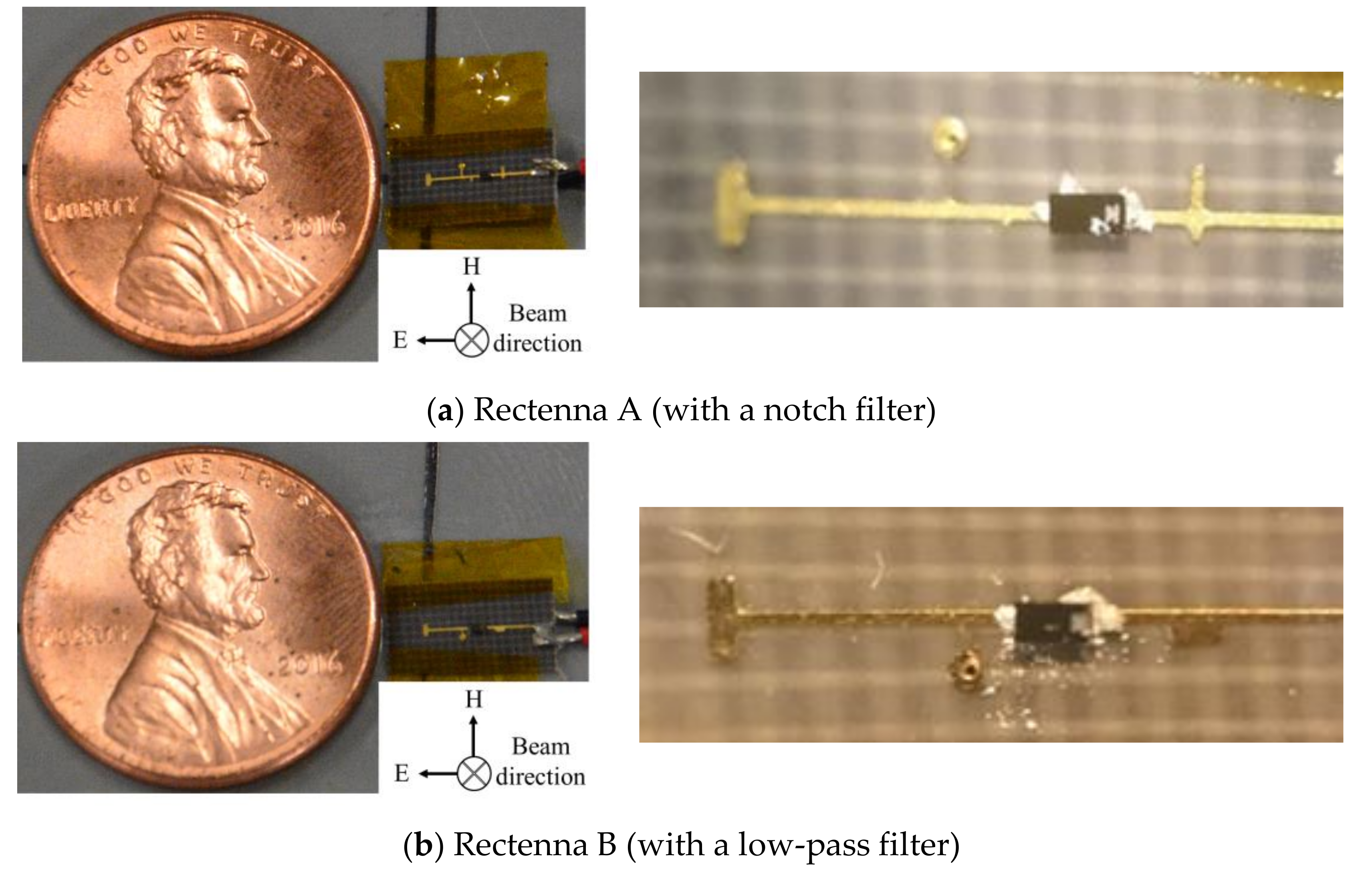
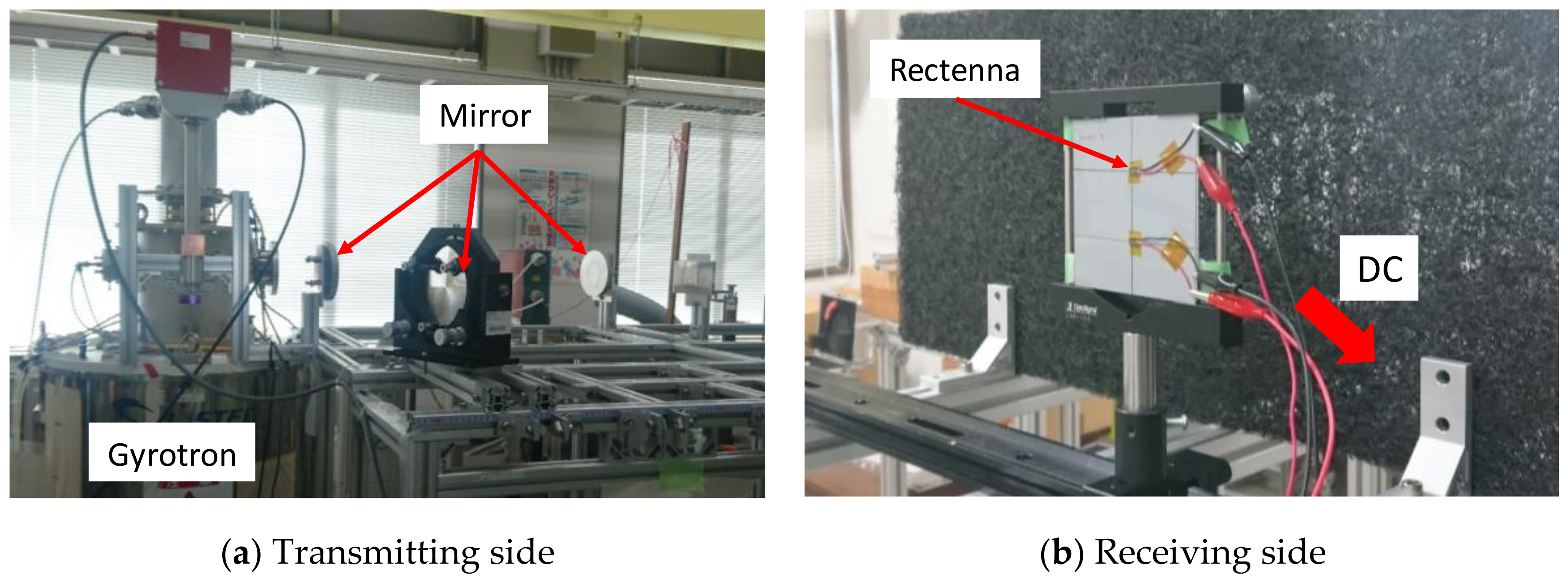
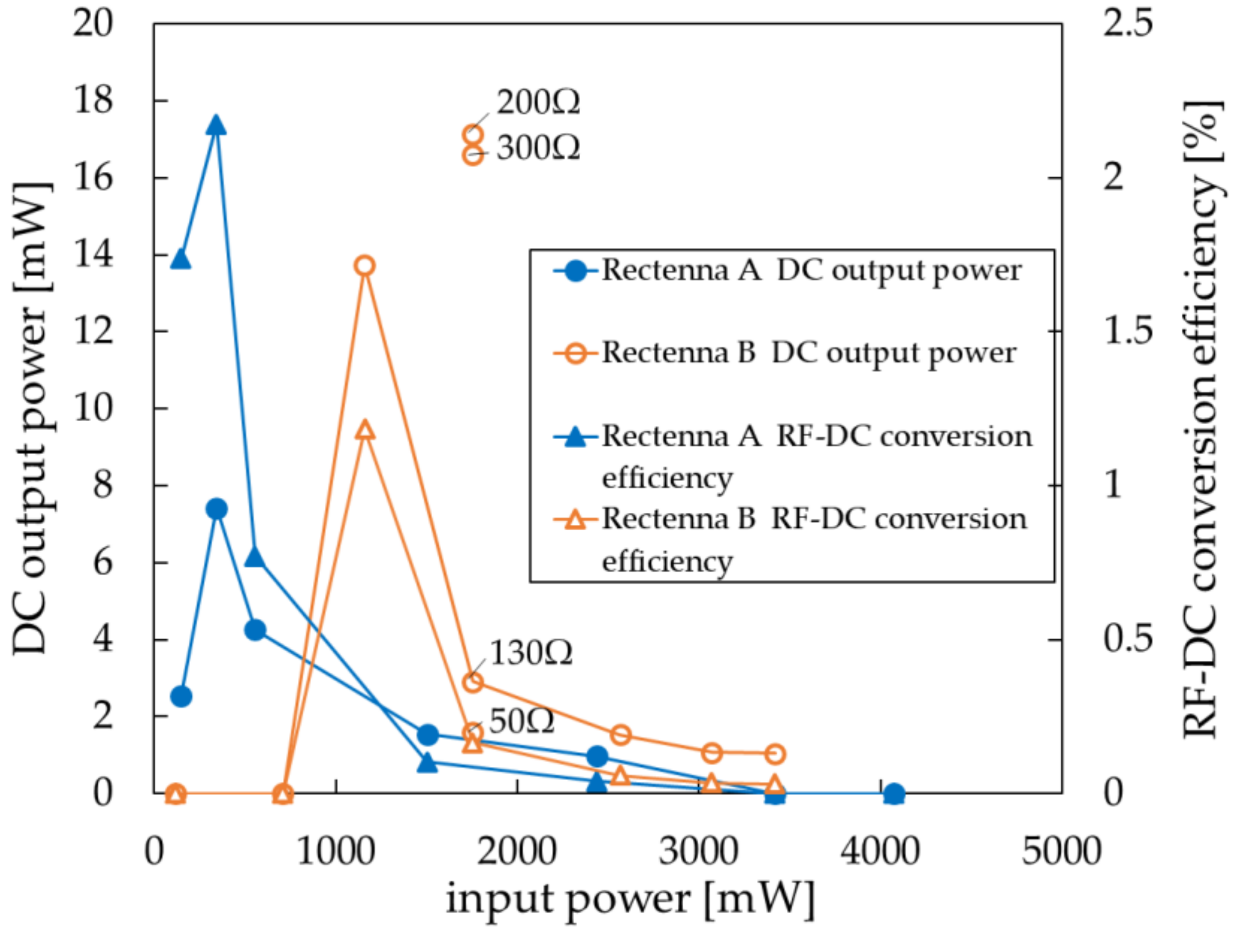
| Reference No. | Frequency [GHz] | DC Output [mW] | RF–DC Conversion Efficiency [%] | Antenna | Diode |
|---|---|---|---|---|---|
| [2] | 2.33 | 2012 | 64 | MSL patch | GaAs FET |
| [3] | 2.45/5.8 | 75.6/40.6 | 84.4/82.7 | CPS dipole | GaAs SBD |
| [5] | 5.8 | 506.7 | 80.3 | Rectifier only | GaAs FET |
| [6] | 9.98 | 74.5 | 75 | MSL patch | SBD |
| [7] | 24 | NA | 65.5 | NA | GaAs SBD |
| [17] | 24 | 100.6 | 47.9 | MSL patch | MMIC |
| [23] | 28 | 140.8 | 47.7 | MSL patch | GaAs SBD |
| [4] | 10/35 | ※81/46.8 | 60/39 | MSL dipole | GaAs SBD |
| [8] | 35 | NA | 72 | MSL patch | GaAs SBD |
| [9] | 35.7 | 4.69 | 67 | MSL patch | GaAs SBD |
| [10] | 60 | 1.22 | 32.8 | Grid antenna | CMOS |
| [13] | 71 | 0.25 | 8 | Monopole | CMOS |
| [14] | 94 | 0.65 | 32.3 | Bow-tie slot | GaAs SBD |
| [15] | 35/94 | ※1.6/0.9 | 53/37 | Taper slot | CMOS |
| [16] | 94 | 0.1 | 10 | Dipole | CMOS |
| [22] | 94 | 15 | 20.5 | MSL patch | Mott diode |
| [18] | 94 | 39 | 38 | Rectifier only | GaAs SBD |
| [24] | 303 | 17.1 | 2.17 | MSL patch | GaAs SBD |
| Reference No. | [17] | [15] | [8] | [4] | [9] | This Work [23] |
| Frequency [GHz] | 24 | 35 | 35 | 35 | 35.7 | 28 |
| Transmission Line | MSL | Slot & GCPW | MSL | MSL | MSL | MSL |
| Technology | MMIC | CMOS 0.13 µm | Dielectric Board | Duroid | Duroid 5880 | Diclad880 (Rogers) |
| Architecture | Class F load + Rectifier | Taper slot antenna+ Transition + BPF + Rectifier | MSL patch antenna + Rectifier | Dipole + LPF + Rectifier | MSL patch 4 × 4 array + LPF + Rectifier | MSL patch + Class F load + Rectifier |
| Diode | NA | CMOS Shottky diode | GaAs SBD | GaAs SBD (DMK6606Alpha) | GaAs SBD (MA4E1317 MACOM) | GaAsSBD (MA4E1317 MACOM) |
| Antenna Gain [dBi] | - | 7.4 | NA | NA | 19 | 9.0 |
| Oscillator | NA | Network Analyzer | Gunn Oscillator & TWTA | Gunn Oscillator | Signal Generator | Gyrotron |
| Oscillator Output Power [W] | NA | ~20 dBm | ~500 | 0.2 | ~20 dBm | 52,900 |
| Rectenna DC Output Power [mW] | 100.6 | 1.6 | NA | 46.8 | 4.69 | 1050 |
| RF-DC Conversion Efficiency [%] | 47.9 | 53 | 72 | 39 | 67 | 47.7 |
| Load Resistance [Ω] | 120 | 100 | NA | 100 | 1000 | 130 |
| Rectenna size [mm2] | 1 × 2.3 | 1 × 2.9 | 120 × 120 | 7.11 × 7.11 | 22 × 42 | 10×20 |
| Rectenna Power density [kW/m2] | 2.38 | 0.55 | - | 0.925 | 0.005 | 0.857 |
| Reference No. | [14] | [15] | [16] | [22] | This Work [18] | This Work [24] |
| Frequency [GHz] | 94 | 94 | 94 | 94 | 94 | 303 |
| Transmission Line | CPW | Slot & GCPW | MSL | MSL | MSL | MSL |
| Technology | Alumina | CMOS 0.13 µm | CMOS 65 nm | Duroid 5880 | NPC-F220A (Nippon Pillar Packing) | NPC-F220A (Nippon Pillar Packing) |
| Architecture | Bow-tie slot antenna + Rectifier | Taper slot antenna + Transition + BPF + Rectifier | Dipole + step-up Transformer + Rectifier | MSL patch 2 × 2 array + Rectifier | Notch filter + Rectifier | MSL patch + Notch or Low-pass filter + Rectifier |
| Diode | GaAs SBD (Virginia diode VDI ZDB) | CMOS Shottky diode | CMOS | Mott diode | GaAs SBD (MA4E1310 MACOM) | GaAs SBD (MA4E1310 MACOM) |
| Antenna Gain [dBi] | NA | 6.5 | NA | 12 | - | 8.32 |
| Oscillator | Klystron | Network Analyzer | solid-state W-band source | Gyrotron | solid-state W-band source | Gyrotron |
| Oscillator Output Power [W] | ~100 | ~20 dBm | 0.14 | ~5000 | ~0.4 | 33,400 |
| Rectenna DC Output Power [mW] | 0.65 | 0.9 | 0.1 | 15 | 39 | 17.1 |
| RF-DC Conversion Efficiency [%] | 32.3 | 37 | 10 | 20.5 | 38 | 2.17 |
| Load Resistance [Ω] | 400 | 100 | 5000 | 200 | 130 | 130 |
| Rectenna size [mm2] | 5.62 | 1 × 2.9 | 0.48 | ※5.1 × 9.4 | 3.6 × 5 | 1 × 5 |
| Rectenna Power density [kW/m2] | 0.17 | 0.31 | 0.038 | 0.3 | 2.38 | 3.43 |
| No. | Distance | CA | Max ηtotal | Theoretical | ||||
|---|---|---|---|---|---|---|---|---|
| ηtotal | ηtr | ηre | ηapr | ηRFDC | ||||
| ● | 900 mm | × | 2.30% | 2.35% | 100% | 32.6% | 15.1% | 47.7% |
| ● | 900 mm | ○ | 1.07% | 3.45% | 83.2% | 57.5% | 15.1% | 47.7% |
| △ | 1350 mm | ○ | 0.12% | 3.22% | 83.2% | 53.7% | 15.1% | 47.7% |
© 2018 by the authors. Licensee MDPI, Basel, Switzerland. This article is an open access article distributed under the terms and conditions of the Creative Commons Attribution (CC BY) license (http://creativecommons.org/licenses/by/4.0/).
Share and Cite
Mizojiri, S.; Shimamura, K. Wireless Power Transfer via Subterahertz-Wave. Appl. Sci. 2018, 8, 2653. https://doi.org/10.3390/app8122653
Mizojiri S, Shimamura K. Wireless Power Transfer via Subterahertz-Wave. Applied Sciences. 2018; 8(12):2653. https://doi.org/10.3390/app8122653
Chicago/Turabian StyleMizojiri, Sei, and Kohei Shimamura. 2018. "Wireless Power Transfer via Subterahertz-Wave" Applied Sciences 8, no. 12: 2653. https://doi.org/10.3390/app8122653
APA StyleMizojiri, S., & Shimamura, K. (2018). Wireless Power Transfer via Subterahertz-Wave. Applied Sciences, 8(12), 2653. https://doi.org/10.3390/app8122653





